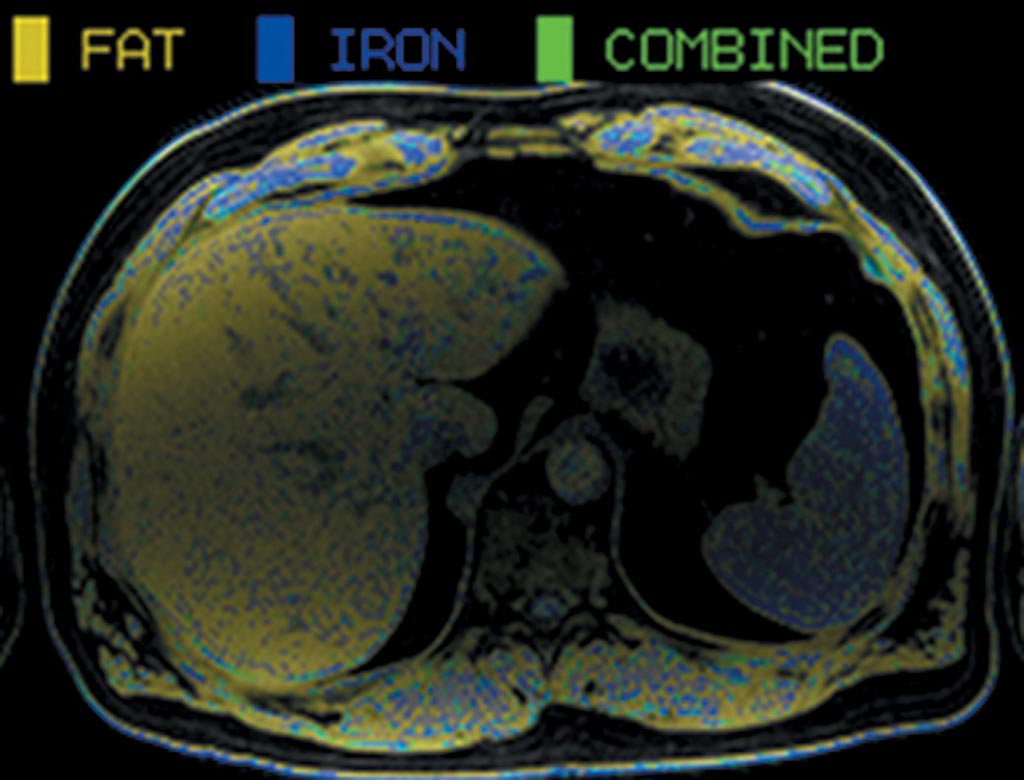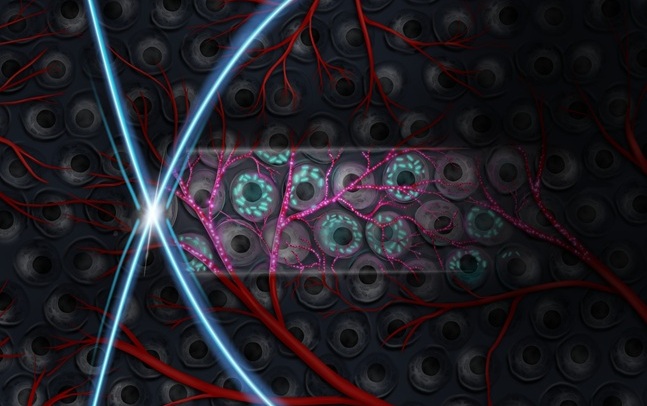MRI Helps Evaluate Potential Living Liver Donors
|
By MedImaging International staff writers Posted on 09 Aug 2017 |

Image: An example of an MRI in a potential living liver donor demonstrating hepatic steatosis (yellow) of the whole liver (Photo courtesy of the University of Toronto).
New magnetic resonance imaging (MRI) contrast agents and pulse sequence techniques can be used to noninvasively evaluate the livers of potential live donors, according to a new review.
Researchers at the University of Toronto (Canada) conducted a review of studies that focusing on the role of state-of-the-art MRI-based techniques in the comprehensive evaluation of living donors in a single-visit. The techniques reviewed include assessment of the liver vasculature via MRI angiography; assessment of the biliary tract via conventional T2-weighted MRI cholangiography and T1-weighted gadoxetate disodium–enhanced MR cholangiography; and evaluation of hepatic steatosis via T2-corrected multiecho chemical shift–based water-fat separation MRI and high-speed T2-corrected multiecho MR spectroscopy (MRS).
Contrast-enhanced MR angiography (MRA), for example, permits hepatic arterial system visualization to the segmental level using gadopentetate dimeglumine as the contrast agent, providing a high signal-to-noise ratio due to its high T1 relaxation rate. Contrast-enhanced MRA has been shown to be as accurate as computerized tomography angiography (CTA) at detecting surgically important anatomic variants of the hepatic vasculature in donor candidates, with accuracy of 86%, 93%, and 68% for the hepatic artery, portal vein, and hepatic vein, respectively.
The increasing use of hepatocyte-specific contrast agent in liver MRI, such as gadobenate dimeglumine and gadoxetic disodium, can accurately display intrahepatic and extrahepatic biliary anatomy. A recent study classified normal and variant biliary systems correctly using a single-dose of gadoxetic disodium enhanced T1-weighted MRC, which could prove an alternative to CT cholangiogram for preoperative evaluation of donor candidates. Other studies show the quality of hepatobiliary phase images obtained using the CAIPIRINHA technique are significantly improved, which could enable gadoxetic disodium–enhanced T1-weighted MRC to provide a better visualization of biliary variants.
MRI techniques can also be used for noninvasive evaluation of hepatic steatosis by separating liver signal into its fat and water signal components first, and then calculating the hepatic fat fraction. MRI-measured hepatic fat fraction, which includes signal fat fraction and proton-density fat fraction, has a strong correlation with histologic grade. The researchers also reviewed MRI and MRS methods used for signal fat fraction and proton-density fat fraction measurement for the evaluation of hepatic steatosis. The review was published in the July 2017 issue of the American Journal of Roentgenology.
“Since the first adult-to-adult transplantation of a right liver lobe reported in 1994, the number of living-donor liver transplants has increased dramatically with good results, similar to those of cadaver liver transplantation,” said lead author Kartik Jhaveri, MD, of the Joint Department of Medical Imaging. “To guide safe harvesting of the graft from donors, an accurate preoperative evaluation of potential living liver donors for conditions that increase the donor's surgical risk is crucial.”
Related Links:
University of Toronto
Researchers at the University of Toronto (Canada) conducted a review of studies that focusing on the role of state-of-the-art MRI-based techniques in the comprehensive evaluation of living donors in a single-visit. The techniques reviewed include assessment of the liver vasculature via MRI angiography; assessment of the biliary tract via conventional T2-weighted MRI cholangiography and T1-weighted gadoxetate disodium–enhanced MR cholangiography; and evaluation of hepatic steatosis via T2-corrected multiecho chemical shift–based water-fat separation MRI and high-speed T2-corrected multiecho MR spectroscopy (MRS).
Contrast-enhanced MR angiography (MRA), for example, permits hepatic arterial system visualization to the segmental level using gadopentetate dimeglumine as the contrast agent, providing a high signal-to-noise ratio due to its high T1 relaxation rate. Contrast-enhanced MRA has been shown to be as accurate as computerized tomography angiography (CTA) at detecting surgically important anatomic variants of the hepatic vasculature in donor candidates, with accuracy of 86%, 93%, and 68% for the hepatic artery, portal vein, and hepatic vein, respectively.
The increasing use of hepatocyte-specific contrast agent in liver MRI, such as gadobenate dimeglumine and gadoxetic disodium, can accurately display intrahepatic and extrahepatic biliary anatomy. A recent study classified normal and variant biliary systems correctly using a single-dose of gadoxetic disodium enhanced T1-weighted MRC, which could prove an alternative to CT cholangiogram for preoperative evaluation of donor candidates. Other studies show the quality of hepatobiliary phase images obtained using the CAIPIRINHA technique are significantly improved, which could enable gadoxetic disodium–enhanced T1-weighted MRC to provide a better visualization of biliary variants.
MRI techniques can also be used for noninvasive evaluation of hepatic steatosis by separating liver signal into its fat and water signal components first, and then calculating the hepatic fat fraction. MRI-measured hepatic fat fraction, which includes signal fat fraction and proton-density fat fraction, has a strong correlation with histologic grade. The researchers also reviewed MRI and MRS methods used for signal fat fraction and proton-density fat fraction measurement for the evaluation of hepatic steatosis. The review was published in the July 2017 issue of the American Journal of Roentgenology.
“Since the first adult-to-adult transplantation of a right liver lobe reported in 1994, the number of living-donor liver transplants has increased dramatically with good results, similar to those of cadaver liver transplantation,” said lead author Kartik Jhaveri, MD, of the Joint Department of Medical Imaging. “To guide safe harvesting of the graft from donors, an accurate preoperative evaluation of potential living liver donors for conditions that increase the donor's surgical risk is crucial.”
Related Links:
University of Toronto
Latest MRI News
- Ultra-Powerful MRI Scans Enable Life-Changing Surgery in Treatment-Resistant Epileptic Patients
- AI-Powered MRI Technology Improves Parkinson’s Diagnoses
- Biparametric MRI Combined with AI Enhances Detection of Clinically Significant Prostate Cancer
- First-Of-Its-Kind AI-Driven Brain Imaging Platform to Better Guide Stroke Treatment Options
- New Model Improves Comparison of MRIs Taken at Different Institutions
- Groundbreaking New Scanner Sees 'Previously Undetectable' Cancer Spread
- First-Of-Its-Kind Tool Analyzes MRI Scans to Measure Brain Aging
- AI-Enhanced MRI Images Make Cancerous Breast Tissue Glow
- AI Model Automatically Segments MRI Images
- New Research Supports Routine Brain MRI Screening in Asymptomatic Late-Stage Breast Cancer Patients
- Revolutionary Portable Device Performs Rapid MRI-Based Stroke Imaging at Patient's Bedside
- AI Predicts After-Effects of Brain Tumor Surgery from MRI Scans
- MRI-First Strategy for Prostate Cancer Detection Proven Safe
- First-Of-Its-Kind 10' x 48' Mobile MRI Scanner Transforms User and Patient Experience
- New Model Makes MRI More Accurate and Reliable
- New Scan Method Shows Effects of Treatment on Lung Function in Real Time
Channels
Radiography
view channel
AI-Powered Imaging Technique Shows Promise in Evaluating Patients for PCI
Percutaneous coronary intervention (PCI), also known as coronary angioplasty, is a minimally invasive procedure where small metal tubes called stents are inserted into partially blocked coronary arteries... Read more
Higher Chest X-Ray Usage Catches Lung Cancer Earlier and Improves Survival
Lung cancer continues to be the leading cause of cancer-related deaths worldwide. While advanced technologies like CT scanners play a crucial role in detecting lung cancer, more accessible and affordable... Read moreUltrasound
view channel
Ultrasound-Based Microscopy Technique to Help Diagnose Small Vessel Diseases
Clinical ultrasound, commonly used in pregnancy scans, provides real-time images of body structures. It is one of the most widely used imaging techniques in medicine, but until recently, it had little... Read more
Smart Ultrasound-Activated Immune Cells Destroy Cancer Cells for Extended Periods
Chimeric antigen receptor (CAR) T-cell therapy has emerged as a highly promising cancer treatment, especially for bloodborne cancers like leukemia. This highly personalized therapy involves extracting... Read moreNuclear Medicine
view channel
Novel PET Imaging Approach Offers Never-Before-Seen View of Neuroinflammation
COX-2, an enzyme that plays a key role in brain inflammation, can be significantly upregulated by inflammatory stimuli and neuroexcitation. Researchers suggest that COX-2 density in the brain could serve... Read more
Novel Radiotracer Identifies Biomarker for Triple-Negative Breast Cancer
Triple-negative breast cancer (TNBC), which represents 15-20% of all breast cancer cases, is one of the most aggressive subtypes, with a five-year survival rate of about 40%. Due to its significant heterogeneity... Read moreGeneral/Advanced Imaging
view channel
AI-Powered Imaging System Improves Lung Cancer Diagnosis
Given the need to detect lung cancer at earlier stages, there is an increasing need for a definitive diagnostic pathway for patients with suspicious pulmonary nodules. However, obtaining tissue samples... Read more
AI Model Significantly Enhances Low-Dose CT Capabilities
Lung cancer remains one of the most challenging diseases, making early diagnosis vital for effective treatment. Fortunately, advancements in artificial intelligence (AI) are revolutionizing lung cancer... Read moreImaging IT
view channel
New Google Cloud Medical Imaging Suite Makes Imaging Healthcare Data More Accessible
Medical imaging is a critical tool used to diagnose patients, and there are billions of medical images scanned globally each year. Imaging data accounts for about 90% of all healthcare data1 and, until... Read more
Global AI in Medical Diagnostics Market to Be Driven by Demand for Image Recognition in Radiology
The global artificial intelligence (AI) in medical diagnostics market is expanding with early disease detection being one of its key applications and image recognition becoming a compelling consumer proposition... Read moreIndustry News
view channel
GE HealthCare and NVIDIA Collaboration to Reimagine Diagnostic Imaging
GE HealthCare (Chicago, IL, USA) has entered into a collaboration with NVIDIA (Santa Clara, CA, USA), expanding the existing relationship between the two companies to focus on pioneering innovation in... Read more
Patient-Specific 3D-Printed Phantoms Transform CT Imaging
New research has highlighted how anatomically precise, patient-specific 3D-printed phantoms are proving to be scalable, cost-effective, and efficient tools in the development of new CT scan algorithms... Read more
Siemens and Sectra Collaborate on Enhancing Radiology Workflows
Siemens Healthineers (Forchheim, Germany) and Sectra (Linköping, Sweden) have entered into a collaboration aimed at enhancing radiologists' diagnostic capabilities and, in turn, improving patient care... Read more




 Guided Devices.jpg)















